Learn step-by-step how to cultivate the fast-growing and nutritious Moringa oleifera (Malunggay) tree in your garden or containers, starting from seeds or cuttings for a rewarding harvest.
Growing your own Moringa oleifera, also known as the “Miracle Tree” or Malunggay, is incredibly rewarding. Not only does it provide a ready supply of highly nutritious leaves and pods right outside your door, but Moringa is also known for its rapid growth and remarkable resilience. It’s surprisingly adaptable and can thrive even in less-than-ideal conditions, making it a fantastic addition to many gardens, especially in warmer climates.
Understanding Moringa’s Ideal Growing Conditions
While adaptable, Moringa thrives best when its preferred conditions are met. Understanding these is key to successfully growing your tree.
Optimal Climate and Temperature
Moringa is a tropical and subtropical plant. It loves heat and performs best in temperatures between 70-95°F (21-35°C). While established trees can tolerate light frost, they are sensitive to freezing temperatures, which can damage or kill them. It’s ideally suited for USDA hardiness zones 9-11. In cooler zones, it can be grown as an annual or in containers.
Sunlight Requirements for Healthy Growth
Full sun is essential for robust growth and maximum leaf production. Aim for a location that receives at least 6-8 hours of direct sunlight per day. While Moringa can tolerate partial shade, growth will be slower and potentially leggier.
Soil Preferences: Drainage is Key
The most critical factor for Moringa soil is excellent drainage. These trees hate having “wet feet” and are prone to root rot in waterlogged conditions. They prefer a sandy loam but will tolerate various soil types, including poor or clay soils, as long as water drains away freely. A slightly acidic to slightly alkaline pH (around 6.3 to 7.0+) is generally suitable.
How to Propagate Moringa: Starting Your Tree
You can easily start growing Moringa using two main methods: seeds or cuttings.
Growing Moringa from Seeds
- Source Seeds: Obtain fresh, viable Moringa seeds from a reputable supplier. Older seeds may have lower germination rates.
- Prepare Seeds (Optional): Some growers soak seeds in water overnight or gently scarify (nick) the hard outer shell to speed up germination, though this isn’t always necessary.
- Planting: Plant seeds about 1 inch (2.5 cm) deep in small pots filled with well-draining potting mix or directly in their final location if the weather is warm enough (after the last frost).
- Germination: Keep the soil consistently moist but not waterlogged. Seeds typically germinate within 1-3 weeks, depending on temperature.
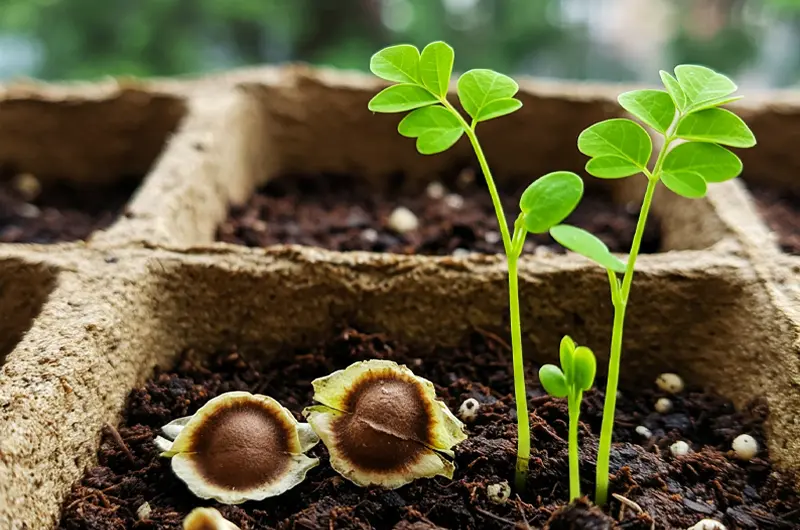
Growing Moringa from Cuttings
- Select Cuttings: Choose healthy, semi-hardwood or hardwood cuttings (at least pencil-thick, ideally thicker) about 1-3 feet (30-90 cm) long from an established tree.
- Prepare Cuttings: Remove leaves from the lower two-thirds of the cutting.
- Planting: Plant the cutting directly into the ground or a large pot, burying about one-third of its length in well-draining soil. Tamp the soil firmly around the base.
- Care: Water regularly, keeping the soil moist until roots develop and new leaves appear. Cuttings often establish faster than seeds.
Planting Your Moringa Tree in the Garden or Pots
Once you have a seedling or cutting ready, it’s time to plant it in its permanent home.
Choosing the Right Planting Location
Select a spot with full sun and well-draining soil. Ensure there’s enough space for the tree to grow, considering it can reach significant heights if left unpruned. Protect young trees from strong winds if possible.
Planting Seeds Directly Outdoors
Wait until all danger of frost has passed and the soil has warmed up. Plant seeds 1 inch deep, water well, and keep the area moist until germination.

Planting Seedlings or Rooted Cuttings
Dig a hole slightly wider and the same depth as the root ball or the buried portion of the cutting. Gently place the plant in the hole, ensuring it’s upright. Backfill with soil, lightly firming it around the base. Water thoroughly after planting.
Spacing Considerations for Moringa Trees
If growing multiple trees and allowing them to reach full size, space them at least 8-15 feet (2.5-4.5 meters) apart. For intensive leaf production where trees are kept heavily pruned, they can be planted much closer, sometimes just 1-3 feet apart.
Caring for Your Growing Moringa Tree
Moringa is relatively low-maintenance once established, but proper care ensures healthy growth and abundant harvests.
Watering Your Moringa Correctly
Young trees need regular watering to establish their root systems. Once established, Moringa is quite drought-tolerant. Water deeply when the top few inches of soil feel dry, but allow the soil to dry out slightly between waterings. Overwatering is a common mistake leading to root rot. Reduce watering during cooler months.
Fertilizing Needs
Moringa typically doesn’t require heavy fertilization, especially if planted in reasonably fertile soil. Incorporating compost or well-rotted manure into the soil at planting time is beneficial. A light application of balanced organic fertilizer during the active growing season can be helpful if growth seems slow or the soil is very poor.
Pruning Your Moringa for Bushiness and Harvest
Pruning is crucial for managing size and encouraging leaf production.
- Pinch Early: Pinch out the growing tip when the tree is young (2-3 feet tall) to encourage branching.
- Regular Pruning: Cut back branches regularly to maintain a bushy shape and keep leaves within easy reach. Moringa responds well to hard pruning. Many growers cut trees back significantly (even to a few feet) annually before the main growing season.
- Harvest Pruning: Harvesting leaves frequently also acts as a form of pruning.
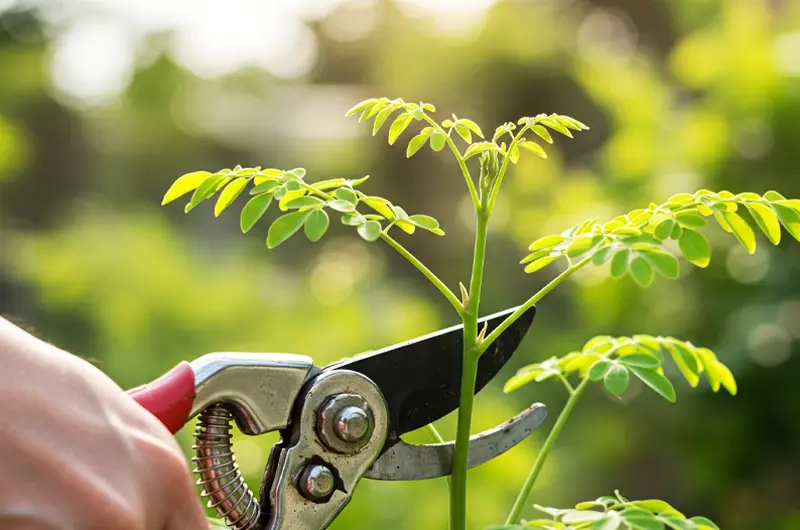
Pest and Disease Management
Moringa is generally resistant to pests and diseases. Occasionally, aphids, spider mites, or caterpillars might appear – these can often be managed with insecticidal soap or manual removal. The primary disease concern is root rot caused by poor drainage or overwatering.
Harvesting Your Homegrown Moringa
One of the greatest rewards of growing Moringa is the harvest!
Harvesting Moringa Leaves
You can start harvesting leaves once the tree is established and has plenty of foliage (often within a few months). Simply pinch off individual leaflets or cut entire stems/branches. Harvest in the morning after the dew has dried for the best quality. Regular harvesting encourages more bushy growth. Leaves can be used fresh, dried, or powdered.
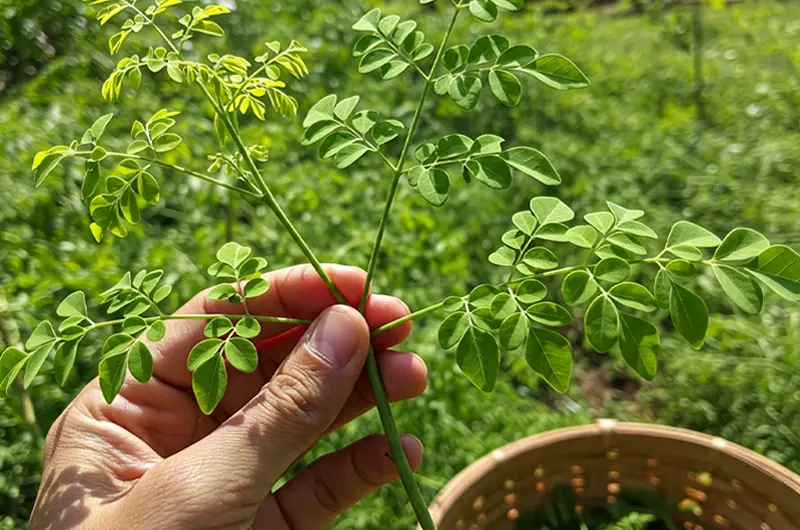
Harvesting Moringa Pods (Drumsticks)
For culinary use, harvest the long pods (drumsticks) when they are young, tender, and about pencil-thick (usually around 1 foot long). Snap easily when bent. Older pods become tough and fibrous, but their mature seeds can be harvested for propagation or oil extraction.
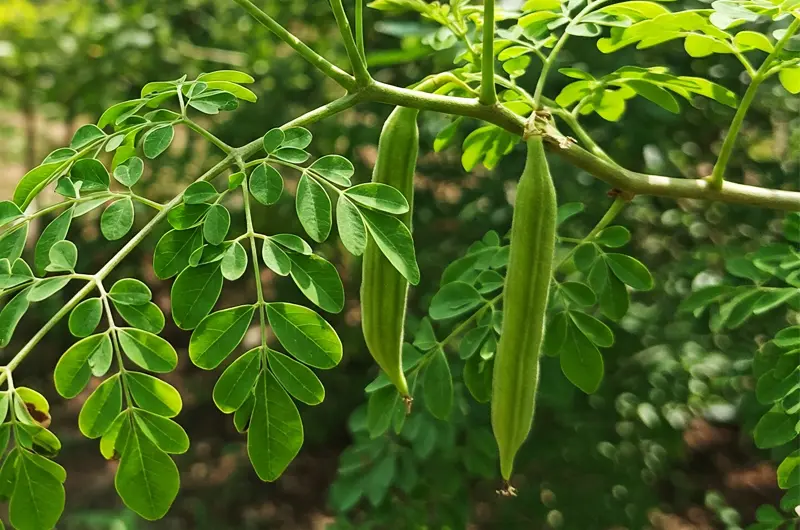
Tips for Growing Moringa Successfully in Containers
If space is limited or you live in a colder climate, growing Moringa in pots is a great option.
- Container Size: Use a large container, at least 15-20 gallons, with ample drainage holes.
- Potting Mix: Use a high-quality, well-draining potting mix; consider adding perlite or coarse sand to improve drainage further.
- Watering: Container plants dry out faster than in-ground plants, so monitor moisture levels carefully. Water when the top 1-2 inches of soil are dry.
- Pruning: Regular, hard pruning is essential to manage size in containers.
- Winter Care: In zones below 9, bring containerized Moringa indoors to a sunny spot or a greenhouse to protect it from frost and freezing temperatures.
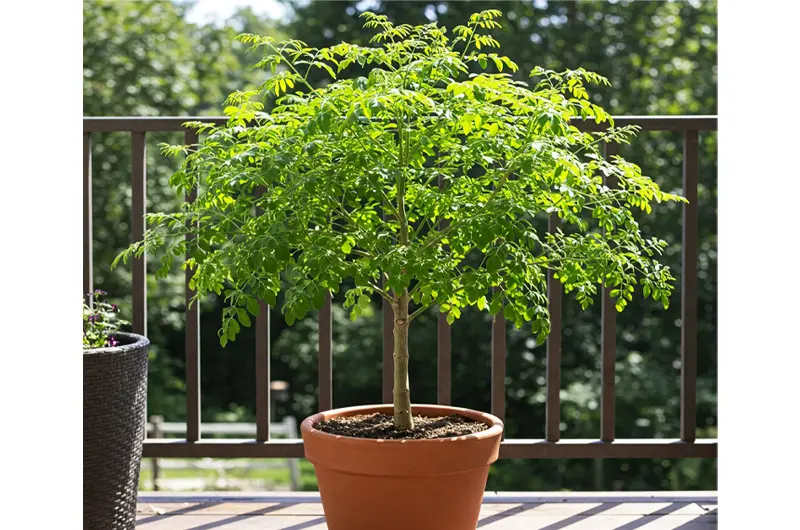
Conclusion: Enjoy the Rewards of Growing Moringa
Growing Moringa oleifera is a simple and highly productive endeavor. With its rapid growth, nutritional benefits, and tolerance for various conditions (especially heat and drought), it’s an excellent choice for gardeners seeking a useful and resilient plant. By providing well-draining soil, plenty of sun, and regular pruning, you can easily cultivate your own “Miracle Tree” and enjoy a continuous supply of fresh, healthy leaves and pods.
Read More about Moringa: Moringa Benefits: Discover the Power of the Miracle Tree
Latest Posts:

